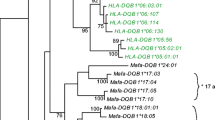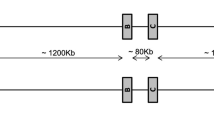Abstract
The major histocompatibility complex (Mhc) consists of class I and class II genes. In the humanMhc (HLA) class II genes, nineDRB loci have been identified. To elucidate the origin of these duplicated loci and allelic divergences at the most polymorphicDRBI locus, introns 4 and 5 as well as the 3′ untranslated region (altogether approximately 1,000 base pairs) of sevenHLA-DRB loci, threeHLA-DRBI alleles, and nine nonhuman primateDRB genes were examined. It is shown that there were two major diversification events inHLA-DRB genes, each involving gene duplications and allelic divergences. Approximately 50 million years (my) ago,DRBI *04 and an ancestor of theDRB1 *03 cluster (DRBI *03, DRBI*15, andDRB3) diverged from each other andDRB5, DRB7, DRB8, and an ancestor of theDRB2 cluster (DRB2, DRB4, andDRB6) arose by gene duplication. Later, about 25 my ago,DRBI *15 diverged fromDRBI*03, andDRB3 was duplicated fromDRBI *03. Then, some 20 my ago, the lineage leading to theDRB2 cluster produced two new loci,DRB4 andDRB6. TheDRBI *03 andDRBI *04 allelic lineages are extraordinarily old and have persisted longer than some duplicated genes. The orthologous relationships ofDRB genes between human and Old World monkeys are apparent, but those between Catarrhini and New World monkeys are equivocal because of a rather rapid expansion and contraction of primateDRB genes by duplication and deletion.
Similar content being viewed by others
References
Andersson G, Larhammr D, Widmark E, Servenius B, Peterson PA, Rask L (1987) Class H genes of the human major histocompatibility complex. J Biol Chem 262:8748–8758
Brändle U, Ono H, Vincek V, Klein D, Golubic M, Grahovac B, Klein J (1992) Trans-species evolution ofMhc-DRB haplotype polymorphism in primates: organization ofDRB genes in the chimpanzee. Immunogenetics 36:39–48
Campbell RD, Trowsdale J (1993) Map of the human MHC. Immunol Today 14:349–352
Cho S, Attaya M, Monaco JJ (1991) New class II-like genes in the murine MHC. Nature 353:573–576
Felsenstein J (1982) Numerical methods for inferring evolutionary trees. Rev Biol 57:379–404
Figueroa F, O'hUigin C, Tichy H, Klein J (1994) The origin of the primateMhc-DRB genes and allelic lineages as deduced from the study of prosimians. J Immunol 152:4455–4465
Fitch WM (1971) Toward defining the course of evolution: minimum change for a specific tree topology. Syst Zool 20:406–416
Gaur LK, Heise ER, Thurtle PS, Nepom GT (1992) Conservation of theHLA-DQB2 locus in nonhuman primates. J Immunol 148:943–948
Grahovac B, Schönbach C, Brändle U, Mayer WE, Golubic M, Figueroa F, Trowsdale J, Klein J (1993) Conservative evolution of theMhc-DP region in anthropoid primates. Hum Immunol 37:75–84
Imanishi T, Akaza T Kimura A, Tokunaga K, Gojobori T (1992) Allele and haplotype frequencies for HLA and complement loci in various ethnic groups. In: Tsuji K, Aizawa M, Sasazuki T (eds) Proceedings of the Eleventh International Histocompatibility Workshop and Conference. Oxford University Press, Tokyo, p 1065
Jurka J Milosavljevic A (1991) Reconstruction and analysis of human Alu genes. J Mol Evol 32:105–121
Karlsson L, Peterson PA (1992) The α chain of the H-20 has an unexpected location in the major histocompatibility complex. J Exp Med 176:477–483
Kasahara M, Klein D, Klein J (1989) Nucleotide sequence of a chimpanzeeDOB cDNA clone. Immunogenetics 30:66–68
Kasahara M, Klein D, Vincek V, Sarapata DE, Klein J (1992) Comparative anatomy of the primate histocompatibility complexDR subregion: evidence for combinations ofDRB genes conserved across species. Genomics 14:340–349
Kawai J, Ando A, Sato T, Nakatsuji T, Tsuji K, Inoko H (1989) Analysis of gene structure and antigen determinants ofDR2 antigens usingDR gene transfer into mouse L cells. J Immunol 142: 312–317
Kelly AP, Monaco JJ, Cho S, Trowsdale J (1991) A new human HLA class II-related locus,DM. Nature 353:571–573
Kenter M, Offing N, Anholts J, Jonker M, Schipper R, Bontrop RE (1992)Mhc-DRB diversity of the chimpanzee (Pan troglodytes). Immunogenetics 37:1–11
Kimura M (1980) A simple method for estimating evolutionary rates of base substitutions through comparative studies of nucleotide sequences. J Mol Evol 16:111–120
Kimura M (1983) The neutral theory of molecular evolution. Cambridge University Press, Cambridge
Kimura M, King JL (1979) Fixation of a deleterious allele at one of two “duplicate” loci by mutation pressure and random drift. Proc Natl Acad Sci USA 76:2858–2861
Klein J (1986) Natural history of the major histocompatibility complex. Wiley, New York
Klein J (1991) Of HLA, tryps and selection: an essay on coevolution of MHC and parasites. Hum Immunol 30:247–258
Klein J, O'hUigin C (1995) Class II BMhc motifs in an evolutionary perspective. Immunol Rev 143:89–111
Klein J, O'hUigin C, Figueroa F, Mayer WE, Klein D (1993b) Different modes ofMhc evolution in primates. Mol Evol Biol 10:48–59
Klein J, O'hUigin C, Kasahara M, Vincek V, Klein D, Figueroa F (1991) Frozen haplotypes inMhc evolution. In: Klein J, Klein D (eds) Molecular evolution of the major histocompatibility complex. Springer-Verlag, Heidelberg, p 261
Klein J, Ono H, Klein D, O'hUigin C (1993a) The accordion model ofMhc evolution. In: Gergely JG, Petranyi G (eds) Progress in immunology, vol. 8. Springer-Verlag, Heidelberg, p 137
Klein J, Satta Y, O'hUigin C, Mayer WE, Takahata N (1992) Evolution of the primateDRB region. In: Tsuji K, Aizawa M, Sasazuki T (eds) Proceedings of the Eleventh International Histocompatibility Workshop and Conference. Oxford University Press, Tokyo, p 45
Klein J, Satta Y, O'hUigin C, Takahata N (1993c) The molecular descent of the major histocompatibility complex. Annu Rev Immunol 11:269–295
Kupfermann H, Mayer WE, O'hUigin C, Klein D, Klein J (1992) Shared polymorphism between gorilla and human major histocompatibility complexDRB loci. Hum Immunol 34:267–278
Lundberg AS, McDevitt HO (1992) Evolution of MHC class II allelic diversity: direct descent in mice and humans. Proc Natl Acad Sci USA 89:6545–6549
Martin RD (1993) Primate origins: plugging the gaps. Nature 363: 223–234
Mayer WE, O'hUigin C, Zaleska-Rutczynska Z, Klein J (1992) Transspecies origin ofMhc-DRB polymorphism in the chimpanzee. Immunogenetics 37:12–23
McDevitt HO (1995) Evolution of MHC class II allelic diversity. Immunol Rev 143:113–122
Miyata T, Yasunaga T (1981) Rapidly evolving mouse α-globin-related pseudogene and its evolutionary history. Proc Natl Acad Sci USA 78:450–453
Nei M, Hughes AL (1992) Balanced polymorphism and evolution by the birth-and-death process in the MHC loci. In: Tsuji K, Aizawa M, Sasazuki T (eds) Proceedings of the Eleventh International Histocompatibility Workshop and Conference. Oxford University Press, Tokyo, p 27
O'hUigin C (1995) Quantifying the degree of convergence in primateMhc-DRB genes. Immunol Rev 143:123–140
O'hUigin C, Klein J (1991) The age and evolution of theDRB pseudogenes. In: Klein J, Klein D (eds) Molecular evolution of the major histocompatibility complex. Springer-Verlag, Berlin, p 287
Rollini P, Mach B, Gorski J (1985) Linkage map of threeHLA-DRβ chain genes: evidence for a recent duplication event. Proc Natl Acad Sci USA 82:7197–7201
Saitou N, Nei M (1987) The neighbor-joining method: a new method for reconstructing phylogenetic trees. Mol Biol Evol 4:406–425
Satta Y (1993) How the ratio of nonsynonymous to synonymous Pseudogene substitution can be less than one. Immunogenetics 38:450–454
Satta Y, O'hUigin C, Takahata N, Klein J (1993) The synonymous substitution rate at the primateMhc loci. Proc Natl Acad Sci USA 90:7480–7484
Satta Y, O'hUigin C, Takahata N, Klein J (1994) Intensity of natural selection at the major histocompatibility complex loci. Proc Natl Acad Sci USA 91:7184–7188
Satta Y, Takahata N, Schonbach C, Gutknecht J, Klein J (1991) Calibrating evolutionary rates at major histocompatibility complex loci. In: Klein J, Klein D (eds) Molecular evolution of the major histocompatibility Complex. Springer-Verlag, Berlin, p 51
Schönbach C, Klein J (1991) TheAlu repeats of the primateDRB genes. In: Klein J, Klein D (eds) Molecular evolution of the major histocompatibility complex. Springer-Verlag, Berlin, p 243
Schönbach C, Vincek V, Mayer WE, Golubic M, O'hUigin C, Klein J (1993) Multiplication ofMhc-DRB5 loci in the orangutan: implications for the evolution ofDRB haplotypes. Mamm Genome 4: 159–170
Servenius B, Rask L, Peterson PA (1987) Class II genes of the human major histocompatibility complex. TheDOβ gene is a divergent member of the class II β gene family. J Biol Chem 262:8759–8766
Stierendregt B, Otting N, Van Besouw N, Jonker M, Bontrop RE (1992) Expansion and contraction of rhesus macaqueDRB regions by duplication and deletion. J Immunol 152:2298–2307
Sloan VS, Cameron P, Porter G, Gammon M, Amaya M, Mellins E, Zaller DM (1995) Mediation by HLA-DM of dissociation of peptides from HLA-DR. Nature 375:802–806
Svensson AC, Setterbald N, Sigurdardottir S, Rask L, Andersson G (1995) PrimateDRB genes from theDRB3 andDRB8 haplotypes containERV9LTR elements at identical positions. Immunogenetics 41:74–82
Takahata N (1990) A simple genealogical structure of strongly balanced allelic lines and trans-specific evolution of polymorphism. Proc Natl Acad Sci USA 87:2419–2423
Takahata N (1994) Polymorphism atMhc loci and isolation by the immune system in vertebrates. In: Golding B (ed) Non-neutral evolution: theories and molecular data. Chapman & Hall, New York, p 233
Takahata N (1995)Mhc diversities and selection. Immunol Rev 143: 225–247
Takahata N, Nei M (1990) Allelic genealogy under overdominant and frequency-depending selection and polymorphism of major histocompatibility complex. Genetics 124:967–978
Takahata N, Tajima F (1991) Sampling errors in phylogeny. Mol Biol Evol 8:494–502
Trowsdale J, Hanson I (1993) MHC genes. In: Solheim BG, Ferrone S, Möller E (eds) The HLA system in clinical transplantation, Springer-Verlag, Berlin, p 41
Trtková K, Kupfermann H, Grahovac B, Mayer WE, O'hUigin C, Tichy H, Bontrop RE, Klein J (1993)Mhc-DRB genes of platyrrhine primates. Immunogenetics 38:210–222
Wolf PR, Ploegh HL (1995) DM exchange mechanism. Nature 376: 464–467
Author information
Authors and Affiliations
Additional information
Correspondence to: Y. Satta
Rights and permissions
About this article
Cite this article
Satta, Y., Mayer, W.E. & Klein, J. Evolutionary relationship ofHLA-DRB genes inferred from intron sequences. J Mol Evol 42, 648–657 (1996). https://doi.org/10.1007/BF02338798
Received:
Accepted:
Issue Date:
DOI: https://doi.org/10.1007/BF02338798




